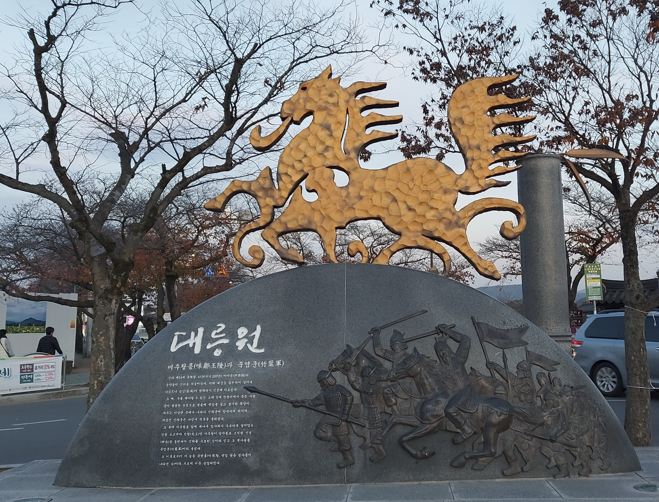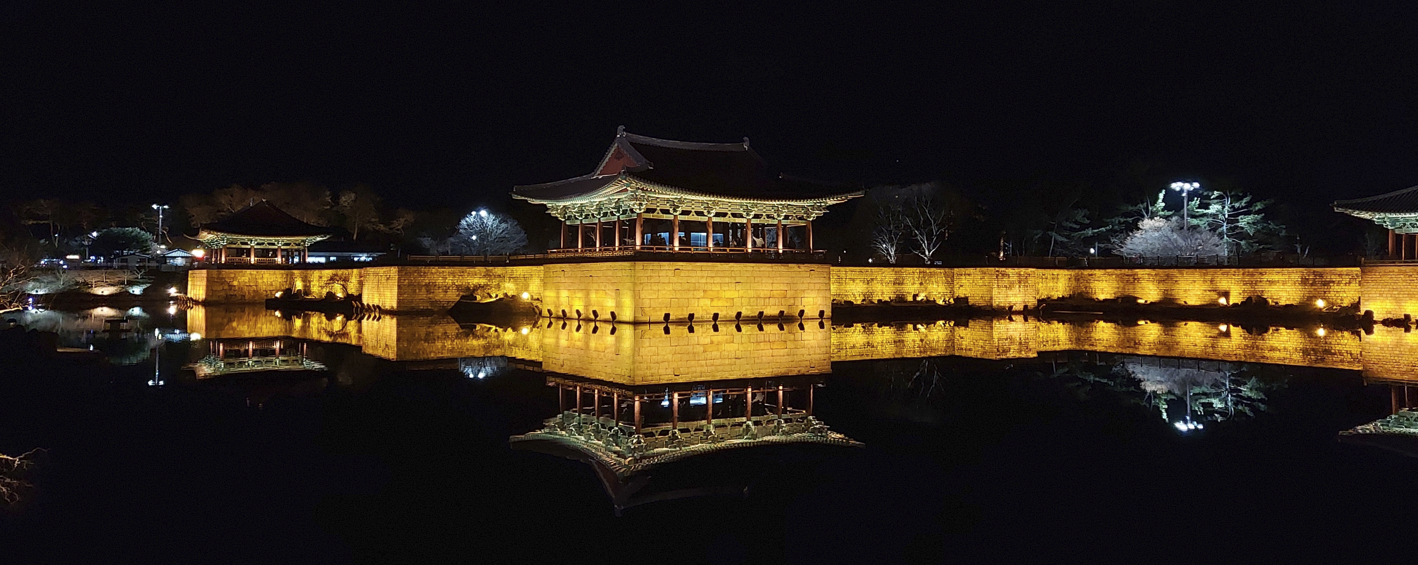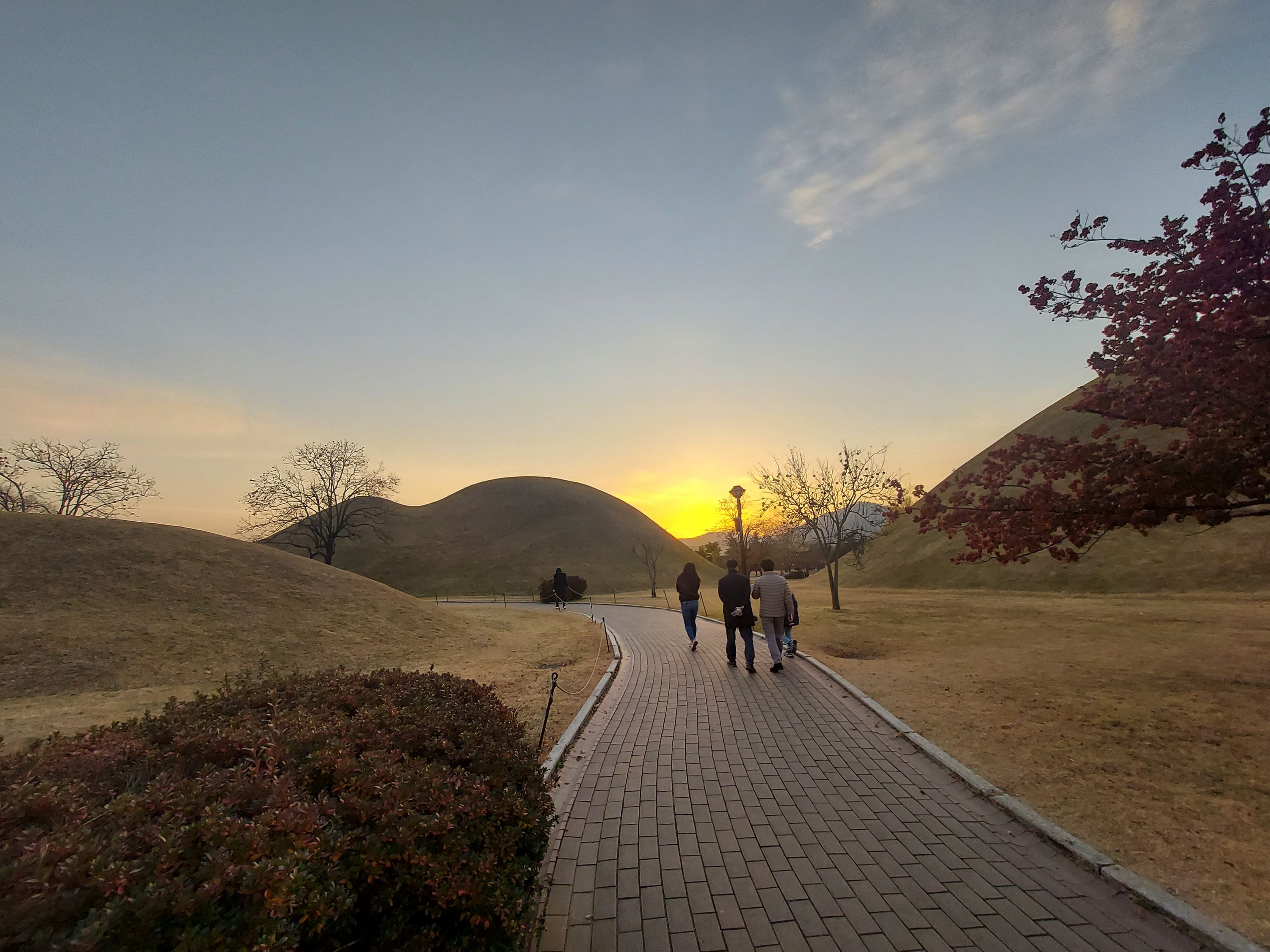|
| Venue & Travel | Home > Venue & Travel |
How to Reach Venue from Incheon Airport
The venue of the conference is Hilton Hotel, Gyeongju (힐튼호텔 경주).
October 27th - November 2nd 2024
- ►The most convenient way to reach Gyeongju from Incheon Airport is by taking an airport limousine bus or train. Here's how to proceed:
-
By Train
You can follow the link in your Naver Map app to check the suitable time for the train depending on your time of arrival at Incheon Airport. The travel will be devided into three parts:- ► From Incheon Airport, take the Airport Express train (AREX) to Seoul Station (서울역). The journey takes approximately 43 minutes.
- ► At Seoul Station, transfer to the Korea Train Express (KTX) bound for Gyeongju Station (경주역) (5 stations, 2 hr 8 min).
- ► Upon arrival at Gyeongju Station, transfer to a bus (bus no. 700 (freq: 4/day), 710 (freq: 14/day)) to reach the bus stop 'Hilton Hotel/KT/Hico' (32 stations, 44 min) followed by a 5 min walk to Hilton Hotel. The total travel time from Incheon Airport to Hilton Hotel, Gyeongju via train is approximately 4 to 5 hours.
- ► You can book the ticket online at Korea Railroad Corporation Website (reservation may be made from 30 minutes to 1 month prior to departure) or Trip.com. The later has partnership with Korail and accepts all kinds of credit cards.
-
By Airport Limousine Bus
- One of the most convenient ways to reach Gyeongju from Incheon Airport is by taking an airport limousine bus. These buses offer comfortable and direct transportation to various destinations across South Korea. To reach Gyeongju:
- ► Upon arrival at Incheon Airport, proceed to the airport limousine bus terminal located outside the arrival hall (Terminal 1: 1st floor exit 11/ Terminal 2: B1 Traffic Center).
- ► Look for Gyeongbuk Ajin Shuttle Bus Contact: (053)355-1241 Hours: 00:00 ~ 11:30 Fare: 43,900 won
- ► Purchase your ticket and board the designated bus.
- ► Sit back and enjoy the scenic journey to Gyeongju. The trip typically takes around 5 to 5.5 hours, depending on traffic conditions.
- ► From Gyeongju Bus station, take a Bus (bus no. 10, 100-1, 150-1, 710) to reach the bus stop 'Hilton Hotel/KT/Hico' (~30 min) followed by a 5 min walk to Hilton Hotel.
-
By Car
- For travelers seeking flexibility and privacy, renting a car or taking a taxi from Incheon Airport to Gyeongju is an option worth considering. While this option may be more expensive than bus or train travel, it offers the convenience of door-to-door transportation. Here's how to proceed:
- ► Rent a car from one of the rental agencies located at Incheon Airport or hire a taxi from the designated taxi stands.
- ► Follow the designated highway routes from Incheon Airport to Gyeongju. The journey by car or taxi typically takes around 4 to 5 hours, depending on traffic conditions and the chosen route.
How to Reach Venue from Gimpo Airport
-
► Unfortunately there is no direct Airport Limousine Bus from Gimpo International Airport to Gyeongju.
-
► Most efficient way would be taking Airport Express train (AREX) from Gimpo Airport Station to Seoul Station (5 stations, 22 min), then transfer to the Korea Train Express (KTX) from Seoul Station to Gyeongju Station (5 stations, 2 hr 8 min)
-
► From Gyeongju Station, take Bus no. 710 or 710 (32 stations, 44 min).
Important Tips
Apps
We recommend to have following apps installed when you visit Korea. These will make your life easier and help you explore Korea in a better way.
(click to download the apps)
- For Navigation: Naver Maps (Recommended), Kakao maps, Google Maps
- For Translation: Google Translate, Papago
Website
Excursion and Banquet
There will be excursions and conference dinner on Wednesday, October 30th.
- Morning Visit to Gyeongju National Museum (optional)
- For those who wish to visit, you can explore the Gyeongju National Museum in the morning. The museum offers free admission to general exhibits. It showcases an impressive collection of Silla artifacts and is a great introduction to the region's rich history. The museum opens at 10:00 AM, and a visit typically takes around 1-2 hours. The bus will pick up people from the museum at 11:30 AM and return to the Hilton Gyeongju Hotel, allowing for lunch (on your own) and rest before the afternoon activities.
- Visits to Bulguksa Temple, Daereungwon Tomb Complex & Cheomseongdae Observatory (1:20 PM - 6:00 PM)
- The main group will depart from the Hilton Gyeongju Hotel at 1:20 PM by bus to visit Bulguksa Temple. The ride takes about 20 minutes. After exploring the temple, the bus will return to the Daereungwon Tomb Complex area and Cheomseongdae Observatory by 4:00 PM. This will give us some time to explore the historic surroundings or relax before dinner.
- Conference Dinner (06:00 PM - 08:00 PM)
- Dinner will be held at Yosukgung 1779 (요석궁1779) and Gyochon 300 Years House (교촌삼백년집), starting at 6:00 PM.
- Free Time at Donggung Palace and Wolji Garden (08:00 PM - 10:00 PM)
- After dinner, we will continue the excursion (for those who registered to attend excursion) to explore the beautifully lit Donggung Palace and Wolji Garden (formerly Anapji Pond; permitted until 10:00 PM), a scenic location illuminated at night.
Explore Gyeongju
Discover the rich history and cultural treasures of Gyeongju, South Korea
About Gyeongju
Nestled in the southeastern corner of the Korean Peninsula lies a city steeped in history and celestial wonder: Gyeongju. Known as the "Museum Without Walls" for its abundance of cultural relics and UNESCO World Heritage Sites, Gyeongju's allure extends far beyond its earthly treasures, delving into the realm of astronomy and cosmic fascination. In present times, Gyeongju boasts remarkable archaeological remnants, including iconic landmarks such as the Cheomseongdae Observatory, Bulguksa Temple, Seokguram Grotto, pagodas, and expansive royal tombs. Among these treasures lie awe-inspiring discoveries, such as dazzling gold crowns and exquisite jewelry, validating the city's alternate title of Kumsong, meaning the 'City of Gold'.

Gyeongju (Kyongju), formerly known as Sorabol or Saro, was the capital of the Silla kingdom of ancient Korea from the 1st century BCE to the 10th century CE. To understand the celestial significance of Gyeongju, one must first unravel the tapestry of its past. Once the capital of the ancient kingdom of Silla (57 BCE - 935 CE), Gyeongju boasts a legacy that spans over a millennium. Its streets are lined with architectural marvels, from the graceful curves of Cheomseongdae, the oldest surviving observatory in East Asia, to the serene beauty of Bulguksa Temple, a testament to Silla's cultural and spiritual zenith.
Cheomseongdae: Gateway to the Stars
.jpg)
The people of Silla were not just stewards of earthly domains but also avid observers of the heavens above. Astronomy held a sacred place in their culture, intertwined with notions of destiny, divinity, and seasonal cycles. In this cosmic dance, Gyeongju emerged as a focal point for astronomical pursuits, with Cheomseongdae standing as a beacon of celestial knowledge.
Constructed during the reign of Queen Seondeok in the 7th century, Cheomseongdae stands as a testament to Silla's astronomical prowess. Its elegant cylindrical form, comprised of precisely cut granite blocks, served as a celestial observatory and calendar, tracking the movements of the sun, moon, and stars with remarkable accuracy. Standing at a towering height of nine meters, the observatory is constructed from 365 meticulously carved granite blocks, arranged in 27 layers. Functioning primarily as a sundial, it also features a strategically positioned south-facing window, designed to capture the sun's rays and illuminate the interior floor during each equinox.
At the heart of Cheomseongdae's significance lies its role in shaping the Silla calendar and guiding agricultural practices. By meticulously charting celestial phenomena, ancient astronomers could predict the changing of seasons, ensuring bountiful harvests and prosperity for the kingdom. Moreover, Cheomseongdae's alignment with the cardinal directions and solstices reflects a deep understanding of cosmic harmony and the interplay between earthly and celestial forces.
Bulguksa Temple

Nestled amidst the verdant slopes of Mount Tohamsan, the Bulguksa Temple, also known as the 'Temple of the Buddha Land', stands as a timeless testament to ancient craftsmanship and spiritual devotion. Erected in the 8th century CE, this architectural marvel is credited to Kim Dae-seong, the esteemed Chief Minister of the Unified Silla kingdom, who envisioned a sanctuary embodying the essence of Buddha's realm - a celestial paradise incarnate on earth. The sprawling temple complex, encompassing tranquil lotus-laden lakes and graceful bridges, alongside its three grand halls, is a manifestation of meticulous planning and precise mathematical precision. Spanning nearly four decades from its inception in 751 CE to its completion in 790 CE, the construction of Bulguksa was a labor of love and dedication, undertaken with unwavering reverence for spiritual sanctity.
While the original wooden structures of Bulguksa have succumbed to the ravages of time and fire, remnants of its ancient glory endure in the form of two magnificent stone pagodas - the Dabotap, or the 'Pagoda of Many Treasures', and the Seokgatap, known as the 'Pagoda that Casts No Shadow'. These venerable pagodas, believed to have been erected in 751 CE, exude an aura of timeless grace and spiritual resonance. In a remarkable archaeological discovery in 1966 CE, excavation around the Seokgatap unveiled a precious relic - a sarira, or reliquary casket, containing the world's oldest woodblock-printed document. Encased within this sacred vessel lay a copy of the Dharani sutra, a profound testament to the enduring legacy of Bulguksa as a custodian of ancient wisdom and spiritual enlightenment.
Donggung Palace & Wolji Pond

Wolji, aptly named "Goose and Duck Lake," emerged from the creative vision of King Munmu during the zenith of the Silla dynasty in February 674. Munmu, the 30th ruler of Silla, inherited a legacy of triumph as his father, King Muyeol, orchestrated the unification of the Korean peninsula, vanquishing the Baekje and Goguryeo kingdoms in 668 and 660, respectively. Today, Wolji stands as a faint echo of its former glory, stripped of its lush vegetation and original architectural splendor. In Munmu's era, it flourished as a paradisiacal retreat adorned with exotic flora and fauna, offering respite and recreation amidst its tranquil environs.
To impress dignitaries from the Tang dynasty of China, Munmu fashioned miniature replicas of the twelve illustrious peaks of Wushan mountain, adorning the terraced landscape surrounding the lake. Here, Chinese envoys found solace in surroundings reminiscent of their homeland's scenic beauty, fostering camaraderie and cultural exchange. Although the pavilions have succumbed to the ravages of time, vestiges of their grandeur endure in the form of weathered foundation stones dotting the lakeside. In a monumental archaeological undertaking in 1972, the Korean government temporarily drained Wolji pond, unveiling a trove of Silla artifacts submerged within its depths. Through meticulous restoration efforts, many of these relics found a new home in the esteemed halls of the Gyeongju National Museum, preserving the legacy of Wolji for generations to come.
Cheonmachong Tomb

Cheonmachong Tomb, translating to "Heavenly Horse Tomb" stands as an iconic testament to the rich heritage of the ancient Silla kingdom. Dating back to the 5th or 6th century CE, this majestic burial mound captivates visitors with its intriguing history and architectural grandeur. The tomb derives its name from the exquisite mural discovered within its chambers, depicting a celestial horse adorned with elaborate trappings. This remarkable artwork, along with other artifacts found within the tomb, offers valuable insights into the religious beliefs, social structure, and artistic sophistication of Silla society.
As one of the largest and best-preserved tombs in Gyeongju, Cheonmachong has become a symbol of cultural pride and archaeological significance. Excavations conducted in the 1970s revealed a treasure trove of artifacts, including exquisite gold crowns, jewelry, pottery, and horse trappings, providing a glimpse into the opulence and splendor of Silla aristocracy. The tomb's construction reflects the meticulous craftsmanship of Silla artisans, with its earthen mound meticulously layered and adorned with carefully arranged stones. The inner chamber, accessed through a long, sloping passageway, housed the mortal remains of an elite member of Silla society, surrounded by offerings and symbols of prestige.
Today, Cheonmachong Tomb stands as a testament to the enduring legacy of the Silla kingdom, inviting visitors to delve into the mysteries of ancient Korean civilization. Its significance extends beyond mere archaeological curiosity, serving as a poignant reminder of the cultural vibrancy and artistic ingenuity of the Silla people. As a cherished landmark in Gyeongju's cultural landscape, Cheonmachong Tomb continues to inspire wonder and admiration, preserving the legacy of Korea's rich historical tapestry for generations to come.
Things to do
Just take bus number 10!. It is also known as the Golden Line. It takes you to all the major tourist spots in Gyeongju. You can find more information here. First Bus: 06:00 Last Bus: 21:40 (based on Gyeongju Express / Intercity Bus Terminal departure)
There are a lots of things that happend in Gyeongju in the fall. We suggest you follow the official website of Gyeongju for the upcoming events.
Where to Eat
Local Delicacies
Gyeongju, known for its rich history and cultural heritage, offers a variety of dishes that reflect its unique culinary traditions. Here are some dishes for which Gyeongju is famous:
- ► Hwangnam-ppang (황남빵): Hwangnam-ppang is a famous traditional pastry from Gyeongju. It's a type of bread filled with sweet red bean paste or other fillings like custard or pumpkin. This iconic pastry is a popular snack among locals and visitors alike and is often enjoyed with a cup of tea or coffee.
- ► Gyeongju Gyodong Beopju (경주 교동법주) Gyeongju Gyodong Beopju is a traditional rice wine with a history dating back over 1,400 years. Made using traditional methods and local ingredients, this rice wine has a smooth and slightly sweet taste. It's often served in traditional Korean restaurants in Gyeongju and is a favorite among locals.
- ► Gyeongju Ssambap (경주쌈밥): Gyeongju Ssambap is a traditional Korean dish consisting of steamed rice served with various vegetables, meats, and condiments. Diners can wrap the rice and fillings in lettuce or perilla leaves and enjoy it as a flavorful and nutritious meal. Gyeongju is known for its fresh and high-quality ingredients, making Gyeongju Ssambap a must-try dish in the city.
- ► Gyeongju Beomppang (경주범빵) Gyeongju Beomppang is a cute and delicious pastry shaped like a bear. Made with a sweet batter and filled with red bean paste or other sweet fillings, Gyeongju Beomppang is a popular street food in the city. It's perfect for satisfying your sweet cravings while exploring Gyeongju's historic sites.
- ► Gyeongju Jumeokbap (경주조민백): Gyeongju Jumeokbap is a type of rice ball made by shaping cooked rice into a fist-sized ball and coating it with various ingredients such as sesame seeds, seaweed flakes, and dried fish. It's a convenient and portable snack that's perfect for picnics or on-the-go eating while exploring Gyeongju's attractions.
Restaurants Around Hilton Hotel
Restaurants with veg/vegan options
(click to open the maps)
- Hilton Silk Road (힐튼경주 실크로드)
- Hilton Le Gourmet Bakery (힐튼경주 르구어메)
- Kyori Gimbapbomunjom (교리김밥보문점)
- Dominos Pizza
- Yeonhwa Baru (연화바루)
- Hyangjeok Won (향적원)
- Vegan Bakery (아이럽베지)
- Chom Chom (촘촘 경주황리단길점)
